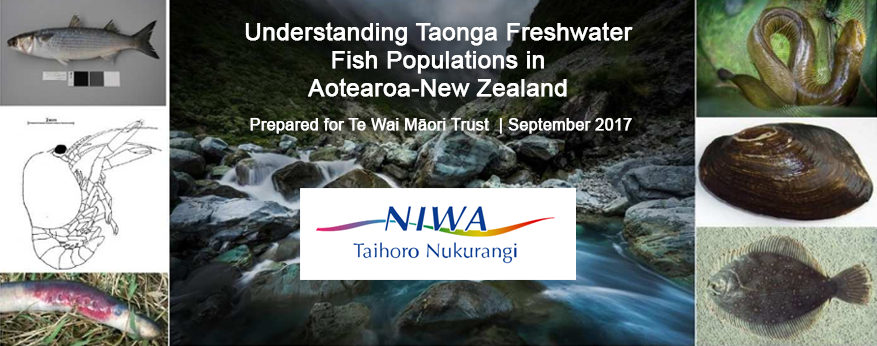
Understanding Taonga Freshwater Fish Populations in Aotearoa-New Zealand
Prepared for Te Wai Māori Trust – September 2017
Understanding Taonga Freshwater Populations in Aotearoa New Zealand
Wai Māori commissioned the National Institute of Water and Atmospheric Research (NIWA) to provide us with a review of current knowledge on Freshwater Populations in Aotearoa/New Zealand. We wanted the review to include: tuna, piharau/kanakana, kōura/kēwai, whitebait, porohe, kanae, patiki mohoao and kākahi/kāeo and cover current knowledge for each species in terms of:
- Understanding the life cycle of each species;
- Aotearoa-NZ distribution;
- State and trends in the relative abundance of populations (if known);
- Threat status, as determined by two methods: NZ Threat Classification System and the International Union for Conservation of Nature (IUCN);
- What we know about pressures on freshwater taonga species populations; and
- Who has responsibilities for managing the fish/fishery.
To the best of NIWA’s knowledge, a stocktake of the current understanding on many of the taonga freshwater fisheries has not been undertaken for some time (since the late Dr Bob McDowall’s book New Zealand Freshwater Fishes: A Natural History and Guide, which was first released 40 years ago).
The different sections were co-authored and/or reviewed by a variety of individuals (including social scientists, fisheries scientists, fisheries managers, post-doc researchers, etc.) who are currently working in the topic areas to ensure that the most recent literature and understanding of current state of knowledge was captured.
As well as information specific to each species, the report also outlines:
- agencies with statutory responsibilities for freshwater taonga species management (and their associated ecosystems, including the marine environment) in New Zealand;
- provision for Māori participation in freshwater resource management across selected legislations, levels of participation and uses the Maniapoto Māori Trust Board and the Waipā Catchment Plan as a case study of how iwi/whānau aspirations for the improved management of freshwater ecosystems and taonga species populations within their rohe can inform and strengthen regional policy and planning processes; and
- government priorities and science strategies of relevance to supporting the health and wellbeing of taonga species populations, and discusses Māori participation in monitoring and evaluation of taonga species. It also sets out some of the research directions required to address key gaps in our knowledge and improve freshwater taonga species co-management.
We are very pleased with the effort the team at NIWA have taken to deliver us a comprehensive and informative report.
Download full PDF here | PDF file 11MB
Download publication in sections:
- Tuna (Freshwater Eels) | PDF file 3MB
- Piharau / Kanakana (Lamprey) | PDF file 1.7MB
- Kōura / Kēwai (Freshwater Crayfish) | PDF file 1.3MB
- Whitebait | PDF file 2.3MB
- Porohe (Smelt) | PDF file 969kb
- Kanae (Mullet) | PDF file 992kb
- Pātiki Mohoao (Black Flounder) | PDF file 928kb
- Kākahi / Kāeo (Freshwater Mussels) | (PDF file 1.4MB)


